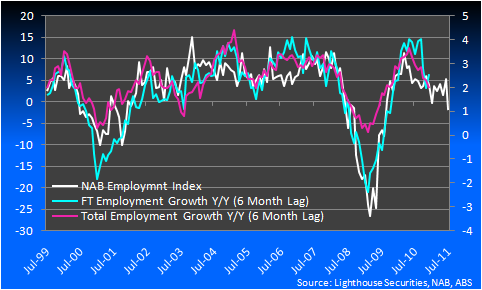
Find below HSBC’s and NAB’s take on today’s jump in unemployment. Both are even handed assessments on the unwinding of labour hoarding but also more sanguine than I am about the immediate trajectory for the jobless rate.
Two reasons I can think of for the weakness concentrated in both WA and QLD. First, that’s where house prices are weakest. Second, both also have large tourism sectors, which will be suffering. Can’t prove either, of course, but the weakness is coming from somewhere.
I would add that Victoria hasn’t created any jobs since February and NSW for a whole year. Both look vulnerable to the same unwind of hoarding if house prices decline further.
Moreover, forward looking indicators like the NAB survey are pointing to further weakness:

And NAB:
Employment fell by 9,700 in August, after a revised fall of 4,100 last month (previously reported as -100 people). Full time employment fell by 12,600 while Part time rose by 2,900. Annual employment growth slipped to 1.2%, from 1.7% in July and down from 3.3% a year ago.
Unemployment rose from 5.1% to 5.3%, up from an equal low of 4.9% in Dec, Apr and May – a rise of 0.4pps in four months. Trend unemployment is rising, now 5.1% from a low of 4.9% in Feb and Mar.
By State, unemployment rose to 5.4% from 5.3% in NSW; for Vic it was flat at 5.1%; in Qld it was 6.2% (from 5.7%); in SA it was 5.1% (from 5.2%); in WA 4.4% (from 4.0%); in Tas it was 5.1% (from 5.2%); in NT it was 4.2% (from 4.1%); and in Canberra it was flat at 4.0%.
The ABS says that 30,000 Census field workers were employed in August but does not say how much this would have boosted employment in the month. The actual effect would have been well short of 30K though, because some of these workers had other jobs prior to, or in conjunction with, the Census work.
This is a disappointing report. The median forecast in the market was for a rise of 10K in jobs and unemployment at 5.1% so the outcome was significantly worse than expected.
Yesterday’s National Accounts showed that domestic demand slowed from 1.4% in the March quarter to 0.7% in the June quarter. Hence, we are inclined to view today’s report as a lagged response to this slowdown in demand.
Weak productivity growth and an acceleration of wages growth are also playing a part, as firms come to the view the ‘labour hoarding’ they have been practicing over the past couple of years might have been overdone.
Rising unit labour costs in the face of slowing demand is a not a recipe for employing more people.Given that domestic demand is likely to have remained subdued in the September quarter, we can’t rule out further rises in the unemployment rate over the next few months. However, we expect the unemployment rate to be trending down again in 2012.
For the RBA, this makes their real job, containing inflation, easier. The slowing in labour demand means downwards pressure on unit labour costs and therefore improves the inflation outlook.
However, the RBA’s ‘sales job’ of explaining to the community why they do not need to cut rates just got harder. There will louder calls for rate cuts now and the market pushed up the chance of a cut by about 14bps (3-year bond futures) in the wake of the release, while the AUD fell by 0.6 of a US cent, before gaining some composure. On an arithmetic basis, cash rate futures have almost three quarters of a percent of easing priced in by the end of the year i.e. a cash rate near 4.0%.
One thing is for sure: they will not be hiking while unemployment is rising.
What would it take to put a cut on the table? A weak enough economy for the staff at the RBA to change their forecasts to show inflation falling back below the bottom for the 2-3% target band.
We are a long way from that position today. All this number does is to put some downside risk on their currently ‘too high’ inflation outlook.
If the US and Europe go into recession and China and the rest of Asia slows down significantly, that might happen. This is a risk but still far from most forecasters’ central case. The most likely outcome is that the RBA continues to sit still for many months ahead.

